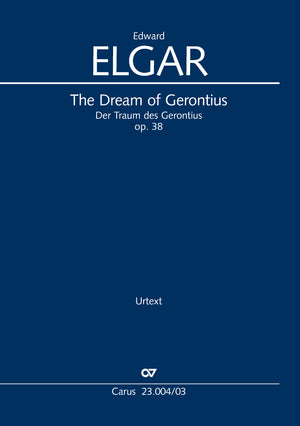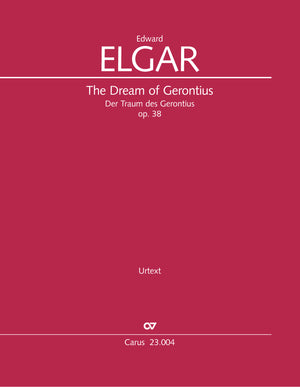Elgar: The Dream of Gerontius, Op. 38
Expected to ship in 1-2 weeks.
- Composer: Edward Elgar (1857-1934)
- Instrumentation (this edition): Piano Reduction, SATB Choir
- Originally for: SATB Choir, Orchestra
- Work: The Dream of Gerontius, Op. 38
- Work Languages: English, German
- ISMN:
- Size: 7.5 x 10.6 inches
- Pages: 176
- Urtext / Critical Edition
Description
"This is the best of me", wrote Edward Elgar after the final measure of his Dream of Gerontius. Premiered in 1900, in Great Britain the work has long been a standard work in the repertoire of large oratorio choirs. Elgar's moving, poetic setting of the eponymous poem by Cardinal John Henry Newman is about a dying man and his journey beyond death to God.
Before the eyes of the listeners, a musical image of the soul is created which flies past mocking demons to God with its protecting angel at its side, is allowed to look at him briefly, then faces the purgatorial fire of salvation confident and comforted. The work is a real rarity in the history of oratorio, and for large choirs it is a thrilling alternative to the established repertoire of Requiem settings. Its popularity is thanks to the suggestive, often sensuous power of the music, the great choral scenes of the demons and the Angel, and the three impressive solo parts.
All previous editions were reprints based on the historic first printed materials, which are inconsistent. By contrast, Carus has produced a modern, newly-engraved edition, compatible in all sections, which takes all the sources into consideration and evaluates the autograph manuscript in detail. for this edition the complete orchestral material is available on sale, and the vocal score and full score contain both English and German singing texts. The full score is also available digitally.
A milestone of late Romantic choral music, and a standard work in Great Britain First modern score with a full Critical Report and complete performance material English and German singing texts
Publishers use a lot of words to describe what they sell, and we know it can be confusing. We've tried to be as clear as possible to make sure you get exactly what you are looking for. Below are descriptions of the terms that we use to describe the various formats that music often comes in.
Choral Score
A score for vocalists that only contains the vocal lines. The instrumental parts are not there for reference. Generally, cheaper than a vocal score and requires multiple copies for purchase.
Facsimile
Reproductions of the original hand-written scores from the composer.
Full Score
For ensemble music, this indicates that the edition contains all parts on a single system (there are not separate parts for each player). In larger ensembles, this is for the conductor.
Hardcover
Hardbound. Generally either linen-covered or half-leather.
Orchestral Parts
Similar to a wind set, this is a collection of parts. In the case of strings, the numbers listed are the number of copies included, though generally these are available individually (often with minimum quantities required).
Paperback
When publishers offer multiple bindings (e.g. hardcover) or study scores, this is the "standard" version. If you're planning to play the music, this is probably what you want.
Performance / Playing Score
A score of the music containing all parts on one system, intended for players to share. There are not separate parts for each player.
Set of Parts
For ensemble music, this indicates that there are separate individual parts for each player.
Solo Part with Piano Reduction
For solo pieces with orchestra, this is a version that contains a piano reduction of the orchestra parts. For piano pieces, two copies are typically needed for performance.
Study Score
A small (think choral size) copy of the complete score meant for studying, and not playing. They make great add-ons when learning concertos and small chamber works.
Vocal Score
A score prepared for vocalists that includes the piano/organ part or a reduction of the instrumental parts.
Wind Set
For orchestral music, this is a collection of wind and percussion parts. The specific quantities of each instrument are notated.
With Audio
In addition to the printed music, the edition contains recordings of the pieces. This may be an included CD, or access to files on the internet.
With / Without Fingering (Markings)
Some publishers prepare two copies - a pure Urtext edition that includes no fingering (or bowing) suggestions and a lightly edited version that includes a minimal number of editorial markings.



